Canon XSi: 12.2 Megapixels, Image Stabilized Lens, and Double Live View
by Wesley Fink on May 5, 2008 3:00 AM EST- Posted in
- Digital Camera
XSi compared to XTi
As the top-selling model in the DSLR universe, each new Canon builds on the previous model's footprint and features. This evolutionary approach keeps new Rebels familiar, but Canon also has managed to keep their entry flagship fresh with the latest must-have features and new Canon innovations.
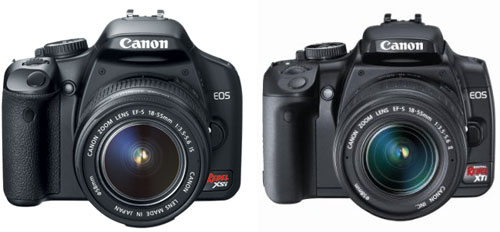
The XSi is more rounded and less angular than the XTi. It is also slightly larger than the XTi to accommodate the larger 3" LCD.
| Canon XSi vs. Canon XTi | ||
| XSi | XTi | |
| Dimensions | 129 x 97.5 x 61.9mm 5.1 x 3.8 x 2.4" |
126.5 x 94.2 x 65mm 5.0 x 3.7 x 2.6" |
| Weight | 475g (16.8oz) - Body only 525g (18.5oz) - with Battery |
510g (18oz) - Body Only 556g (19.6oz) |
The XSi is 2.5mm wider and 3.3mm taller than the XTi. However, it is 3.1mm less deep and 35g lighter than the current XTi. The overall impression is the XSi is slightly larger than the XTi, and it is surprisingly light. The rubber grip cover is now more "texturized" with subtle changes to the shutter release depression and angle. The grip is more comfortable to hold for larger hands (still improved by adding the grip), but it is a good fit for smaller hands.
Build quality seems a cut above earlier Rebels and the appearance is definitely classier and more in keeping with the rest of the Canon DSLR line. The XSi has been described as looking like a mini 40D and that is an apt description. The XSi is also the most rugged Digital Rebel ever built with a stainless-steel chassis and a glass-reinforced engineering plastics body.
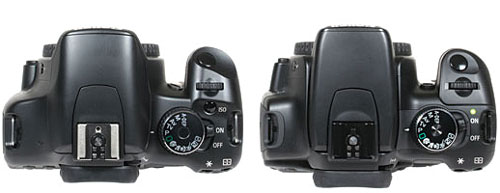
The XTi ON LED is gone, something that may matter to some users. If you look closely you can see that the shallower XSi is entirely due to the stubbier pentamirror/flash housing, which does not overhang as much as in the XTi.
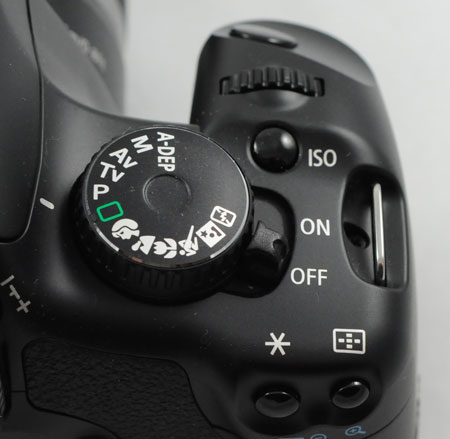
The XSi adds an ISO button just above the on-off switch. ISO is also now displayed in the viewfinder (finally!).
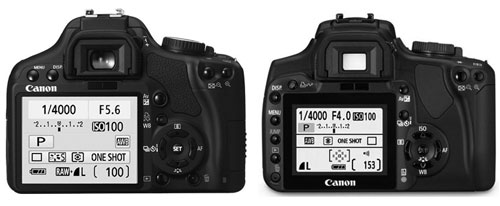
The biggest changes in the XSi are on the back where the new 3" LCD looks absolutely massive compared to the XTi's 2.5" screen. The 3" screen is the same size and specifications as the Canon 40D screen. It is also the largest screen in its class - the Nikon D60 and Olympus 510/420 are 2.5", while the Sony A350/300/200 and Pentax K200D are 2.7".
The larger screen on the XSi required a complete rearrangement of rear buttons as well. There are no longer buttons on the left and the Menu and Display buttons are now at the top left of the screen.
The right side control buttons and layout are basically the same as the XTi, with the addition of the playback and delete (trash) buttons at the bottom right of the screen. The drive/timer button has been reassigned to a directional pad button and the old button is now assigned to White Balance. In a quick glance at the XSi rear you would think it has been simplified, as it looks as if there are fewer buttons. However, all the buttons and functions are still there; they are just rearranged.

The XSi is the first Canon camera to use SD cards, a break with all previous Digital Rebels that used Compact Flash cards. This is really not a handicap at all since SD cards are now priced about the same as Compact Flash. The latest Class 6 SDHC cards are also very fast, just like the high-speed CF cards. All test shots with the XSi used a 16GB Class 6 SDHC card for image storage. The operation was trouble free and very fast.

XSi introduces a new battery that is incompatible with past models. The electrical contacts are contained in the bump on the battery - presumably to prevent accidental contact and discharge in the camera bag. The new LP-E5 (50g) rechargeable battery weighs about the same as the NB-2LH (46g) which powered the XT and XTi models. However, battery output increases about 50% to 1080 mAh compared to the 720 mAh of the NB-2LH. Battery life was not an issue with the XTi as Canon CMOS sensors are justly famous for low power consumption. The XSi battery life is even better, with plenty of reserve for driving the 3" LCD and Live View.
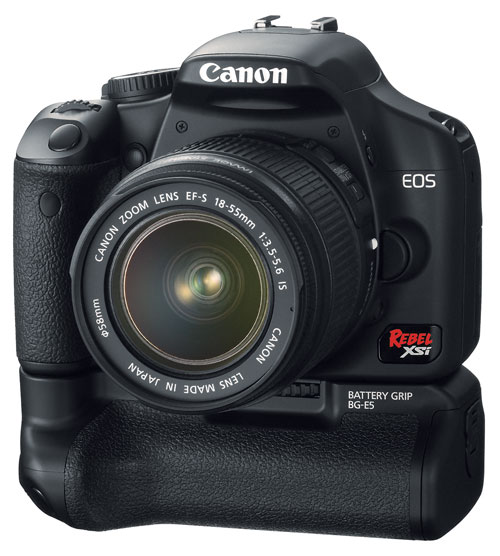
With the new LP-E5 battery also comes a new battery grip called the BP-E5. Then new BP-E5 works only on the XSi; it is incompatible with the earlier Digital Rebel grip. The earlier BP-E3 will not work on the XSi.
The new BP-E5 requires the battery cover be removed for mounting. The grip has a place to store the battery cover on the grip so it is not lost. Power for the grip is either one or two LP-E5 batteries. The grip also comes with an AA battery holder for six AA-size batteries as an alternate power source. We tested the grip with high-capacity rechargeable AA batteries and they worked fine as a power source.
It is definitely worth mentioning that the grip with two BP-E5 batteries is still extremely light, but the two dedicated batteries pack a wallop with 2160 mAh available. Unlike the Sony proprietary batteries, the new LP-E5 batteries are already available OEM from third party vendors.
An added feature of the BP-E5 is that it does provide some weather sealing, unlike the previous Digital Rebel grip. While Canon does not make a big deal of the feature, the XSi does provide some weather sealing, which is more a prosumer model feature.










56 Comments
View All Comments
Devo2007 - Monday, May 5, 2008 - link
I've been quite happy with Anandtech's camera reviews so far, along with the articles on digital photography (terms, sensor info, etc.)I'm still torn between the Rebel XSi and the Sony A350. Live View isn't extremely important to me (even on my current camera, I don't use the LCD that much), but I also want something that's going to be relatively easy to use. I've never used an SLR before (film or digital), though I have worked with the manual controls on my existing camera a bit.
haplo602 - Monday, May 5, 2008 - link
I personaly would go with Canon in this case. You will find a huge supply of cheap used lenses and other accessories on ebay :-)Go check ...
As fo ease of use, the only option is to visit a larger camera store and try out. There is no substitute for experience.
casteve - Monday, May 5, 2008 - link
I wonder if Sony provides free rootkit malware with their cameras, too!n4bby - Monday, May 5, 2008 - link
but i never quite understood why anandtech started reviewing photo gear... i appreciate the considerable effort that went into this review, but quite frankly i think cameras are better reviewed by professional photographers and/or specialists in the field. again, not meaning to rag on you but the sample photographs are really quite sub-par from both a technical and aesthetic standpoint and in no way show what this or really any camera/lens is capable of. i think without an adequate photographic background, it is hard and perhaps somewhat misguided to critically evaluate the merits of the gear beyond the merely technical, which i understand is what the majority of people come to this site for. but photography being an art goes much beyond the technical and i think the subjective element of it is often very relevant to the judgment of equipment.Sunrise089 - Monday, May 5, 2008 - link
Super-elitist arguments are funny in posts that refuse to capitalize words.I have seen professional camera review sites and magazines, although I am by no means an expert in the subject. Besides reaching a different audience, Anandtech seems to bring two things to the table with these reviews: 1) Objective and numbers-based analysis, and 2) Clear conclusions. Many reviews of high-end products, be they cars, home theater gear, or cameras, seem to lack clear "this product is better than this product for this type of user" conclusions (probably their tiny audiences cannot sustain their publication costs without free sample gear, and so they avoid hard conclusions because they don't want to piss off any company and stop of flow of free gear. Anandtech provides a refreshing and readable change of pace, that for this user at least the reviews are exactly what I desire.
Justin Case - Monday, May 5, 2008 - link
[quote]Anandtech seems to bring two things to the table with these reviews: 1) Objective and numbers-based analysis, and 2) Clear conclusions.[/quote]And that is precisely the problem, because most of the times the numbers are wrong (or inconsistent, because the reviewer didn't understand what he was actually measuring), which means the "authoritative sounding" conclusions are also wrong, and misleading.
There's nothing worse than an ignorant who's sure of himself. No, wait, there is. An ignorant who's sure of himself and gives authoritative advice to thousands of other people.
Photography, like so many other fields where art meets technology, is not about clear conclusions. Some of the greatest photographs in the word were taken with cameras that would rank at the bottom in any "number based analysis" (just look at anything by Cartier-Bresson, for example).
Describing a camera's performance in (objective) numbers and writing requires a lot of experience, and so does understanding it. For "average users" the way to go is look at a lot of samples (with different lighting conditions, different subjects, etc.) and read people's pondered (subjective) opinion about their experience with the camera, and how it compared to other cameras.
"Number-based clear conclusions" are like trying to define Van Gogh, John Lennon or Jesus Christ by their IQ score and shoe size. Those are certainly useful pieces of information, but if you draw a "clear conclusion" from them, you are missing the point.
Wesley Fink - Monday, May 5, 2008 - link
The Canon XSi is an entry DSLR. 99% of its buyers will be consumers like readers at AnandTech. I would venture a guess than the great majority of those potential buyers really don't care how the entry priced XSi performs with a $2000 Canon L lens in a studio setting.Using your logic none of us would ever build a computer since it is a task best left to Pros like Dell and HP, and reviewing home PCs should be left to IT professionals.
Not.
Justin Case - Monday, May 5, 2008 - link
We are talking about reviewing a product, not building it, so your criticism of the poster's "logic" makes no sense. Certainly people shouldn't build PCs professionally without knowing how a PC is built. You don't write just for yourself, you write for Anandtech as a professional journalist. To use your analogy, you _are_ (supposedly) the "Dell and HP" of product reviews.Cameras should be reviewed by people with experience (preferably photographers) for the same reason that cars should be reviewed by experienced drivers, guitars should be reviewed by experienced musicians, and so on. Because people with more experience (with different situations and different products) are more likely to have relevant insights about how the product they are reviewing compares to the rest.
If I'm clueless about, say, air compressors, the last thing I need is advice from an equally clueless person, just because he's an "average user". The expression "expert advice" carries weight for a reason. I don't think this is so hard to understand.
The section for the "average guy review" is the "comments" section at the bottom. Anadtech's readers expect the actual _articles_ to be written by experts, and to follow a professional, relevant methodology. And (some of) the IT articles actually do (Anand's and Johan's, mostly).
Taking pictures of a bunch of boxes on top of a desk (often with nonsensical camera and lens settings, different settings for different cameras, etc.) is something that might meet the standards of a private blog, but not really the standards of a site like Anandtech.
If you can't do something at least _half_ as good as the main photography websites and if you're reviewing a product that has already been reviewed ad nauseum by all those sites... why bother? I guess it increases the number of ad impressions, and maybe you get paid by nVidia, Corsair and Intel to use their logos as your "test images", but is that really worth the impact on Anandtech's reputation?
If you don't have the knowledge, time or resources to make a proper _technical_ evaluation of the camera and lens, just write an _opinion_ piece. Photography magazines are full of them, and they're quite useful.
Take a few photos (of different things: people, buildings, sunsets, flowers, cars, night scenes, indoors shots, etc.), post your results and write about your experience using the camera for a week or two. Less press-release, less spec sheet, less "hacked together" photographic tests, more real-world samples and more subjective opinion about real-world photos, clearly identified as such. That might actually have some relevance, and would complement the more technical articles found in photography websites.
JarredWalton - Monday, May 5, 2008 - link
I can attest to the fact that Wes knows *FAR* more about cameras than the rest of us at AnandTech. Some of you may not feel that way from reading some of his articles, but I wonder how much you're actually reading and how much you're assuming. He's done photography work professionally in the past, and we all tend to discuss things with him when we need camera advice. To pretend that he lacks knowledge of a subject just because you disagree with some aspect of an article is typical of anonymous internet users.Why does he use a setup where he's photographing a bunch of computer hardware boxes? For one, I'm sure the fact that it's inside in a controlled environment and has a bunch of stuff that doesn't change constantly helps. Taking a picture of some outside scene is fine, but it doesn't allow apples-to-apples comparisons. It really would be great for Wes to include some other sample images, I agree. You know, sort of like he does on page 12.
I'm sure he can add more photos there showing other shooting environments, but it's pretty easy to take a few shots under specific conditions and come up with a conclusion that "this camera is AWESOME!" That's what a lot of people tend to do. A great photographer taking pictures can make even lousy cameras look good, which is why we need a controlled environment.
For me, being able to easily take a quality picture under tungsten lighting is in fact one of the best ways to separate average cameras from great cameras... it would be quite entertaining to see some point-and-shoots try out his test. I say that because I upgraded from a point-and-shoot to a DSLR purely for the fact that after trying three PAS cameras I still couldn't manage to capture good quality photos of products.
Justin Case - Tuesday, May 6, 2008 - link
It has nothing to do with his opinions. It has to do with inconsistent (and plain wrong) methodology, lack of varied samples (all the "sample photos" seem to have been taken in 20 minutes, at the same place), and poor quality of the photos in general (all but two have bad framing, bad exposure and bad use of DOF - they're fine as holiday snaps, but not really the work of an "experienced photographer").In fact, about the _only_ thing about his articles worth reading is his opinion (which, sadly, he insists on basing on fundamentally flawed "technical" tests, instead of basing it on real-world experience with the cameras - you know, the kind that really matters for people who are going to use it instead of sit at home "measurebating").
Outdoors photos don't allow for an "apples to apples" comparison? So you'd rather compare just the apple seeds, because the rest of the apple might be different? You think 50 photos of an nVidia box give you more information about how two cameras perform in the real world than, say, 20 photos taken in different conditions? Or is this review aimed at that very specific market niche of people who photograph nVidia logos on boxes that happen to be on their desk?
If he knows *FAR* more about cameras than anyone else at Anandtech (and I'm starting to think that might be true, which is scary), that makes it pretty clear that Anandtech shouldn't be doing camera reviews. For one thing, how will the rest of the people at Anadtech know that he's not publishing nonsense (answer: clearly, they don't)?
Seriously: _You_ (Jarred), spend two weeks taking pictures (indoors, outdoors, day, night, portraits, babies, flowers, cars, sports, dogs, landscapes, clouds, flash, no flash). Pick the 20 or 30 photos you consider more relevant (because they came out right or because they came out wrong or just because they came out different from what you expected). Write an article about your experiences with the came and comment on each photo. Skip the technical "camera" stuff; it's been done properly by people who know how to do it at specialized websites, and "average users" don't understand it anyway, even if they think they do. Give us your opinion and different samples taken in different conditions. If you can take similar photos with multiple cameras, even better. If not, nevermind, just try to photograph many different situations. I'm sure the end result will be a million times better (and more relevant) than Mr. Fink's "let's test sensor sharpness by setting lenses to f/1.2" pseudo-technical articles.
PS - FYI, P&S cameras will generally perform *better* than dSLRs under tungsten lighting, if you have both set to full auto (certainly better than Canon dSLRs, which have very crappy auto WB under tungsten). As long as you do in-camera white balance (or shoot raw) and expose correctly, both P&S and dSLRs should perform fine (as far as white point is concerned; P&S cameras are still noisier, have worse lenses, less control over DOF, etc).